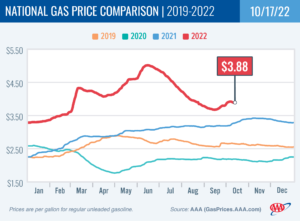WASHINGTON
,
October 17, 2022
(press release)
–
Fears of a global economic recession led to a major drop in the price of crude, down $7, which helped to minimize pump price increases last week. Meanwhile, domestic gasoline demand decreased as fewer drivers fueled up in the first half of October. According to the Energy Information Administration (EIA), gas demand decreased nationally from 9.47 million b/d to 8.28 million b/d, and total domestic gasoline stocks increased by 2 million bbl to 209.5 million bbl. Lower gasoline demand, amid increasing supply and fluctuating oil prices, has contributed to the national average moving downward. If demand continues to drop coupled with a slide in oil prices, drivers could see increases in prices at the pump start to slow and even come down through the week. The national average pump price for a gallon of gas decreased three cents over the past week to hit $3.88. Today’s national average of $3.88 is 20 cents higher than a month ago and 56 cents more than a year ago. Quick Stats The nation’s top 10 largest weekly decreases: California (−28 cents), Wisconsin (−23 cents), Oregon (−19 cents), Nevada (−18 cents), Michigan (−16 cents), Washington (−14 cents), Alaska (−12 cents), Indiana (−12 cents), Ohio (−12 cents) and Arizona (−10 cents). The nation’s top 10 least expensive markets: Georgia ($3.25), Texas ($3.30), Mississippi ($3.33), South Carolina ($3.37), Arkansas ($3.38), Tennessee ($3.38), Louisiana ($3.40), Florida ($3.40), Alabama ($3.43) and Missouri ($3.46). Oil Market Dynamics At the close of Friday’s formal trading session, WTI decreased by $3.50 to settle at $85.61. Crude prices decreased last week as global economic fears pulled crude prices lower. For this week, crude prices could continue to weaken as interest rates rise globally, which could lead to a recession. If a recession occurs, crude prices would likely reduce alongside demand. Additionally, EIA’s latest weekly report showed that total commercial crude inventories increased by 9.9 million bbl to 439.1 million bbl. Drivers can find current gas prices along their route using the AAA TripTik Travel planner. 
* All content is copyrighted by Industry Intelligence, or the original respective author or source. You may not recirculate, redistrubte or publish the analysis and presentation included in the service without Industry Intelligence's prior written consent. Please review our terms of use.




